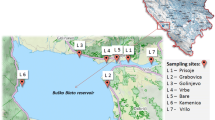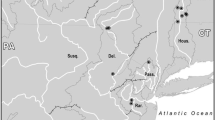Abstract
Gilbert's Potoroo isAustralia's most critically endangeredmarsupial, known from a single population inthe Two Peoples Bay National Park in WesternAustralia. We present results from a study ofgenetic variation in microsatellite andmitochondrial DNA. Mean heterozygosity at fivemicrosatellite loci was 49.3%, and the amountof mtDNA variation was extremely low (π =0.0004). There was evidence for a bottleneckin both sets of markers, and this wasconsistent with a demographic decline. Effective population size was estimated usingtwo different models of mutation formicrosatellites (N e = 243 and 362). The results from this study highlight theconcern for the long-term survival of thisspecies.
Similar content being viewed by others
References
Campbell NJH, Harris FC, Elphinstone MS, Baverstock PR (1995) Outgroup heteroduplex analysis using temperature gradient gel electrophoresis: high resolution, large scale, screening of DNA variation in the mitochondrial control region. Mol. Ecol., 4, 407–418.
Cornuet JM, Luikart G (1996) Descriptions and power analysis of two tests for detecting recent population bottlenecks from allele frequency data. Genetics, 144, 2001–2014.
Crandall KA, Posada D, Vasco D (1999) Effective population sizes: Missing measures and missing concepts. Anim. Cons., 2, 317–319.
Crow JF, Kimura M (1970) An Introduction to Population Genetic Theory. Harper & Row, New York.
Dickman CR (1992) Conservation of mammals in the Australasian region: The importance of islands. In: Australia and the Global Environmental Crisis (eds. Coles JN, Drew JM), pp. 175–214. Academic Press, Canberra.
Di Rienzo A, Peterson A, Garza JC, Valdes AM, Slatkin M, Freimer NB (1994) Mutational processes of simple-sequence repeat loci in human populations. Proc. Nat. Acad. Sci., 91, 3166–3170.
Eldridge MDB, King JM, Loupis AK, Spencer PBS, Taylor AC, Pope LC, Hall GP (1999) Unpredented low levels of genetic variation and inbreeding depression in an island population of the black-footed rock-wallaby. Cons. Biol., 13, 531–541.
Franklin, IR (1980) Evolutionary change in small populations. In: Conservation Biology: An Evolutionary-Ecological Perspective (eds. Soulé ME, Wilcox BA), pp. 135–150. Sinauer Associates, Sunderland.
Fumagalli L, Moritz C, Taberlet P, Friend JA (1999) Mitochondrial DNA sequence variation within the remnant populations of the endangered numbat (Marsupialia: Myrmecobiidae: Myrmecobius fasciatus). Mol. Ecol., 8, 1545–1549.
Gerber AS, Templeton A (1996) Population sizes and within-deme movement of Trimerotropis saxatilis (Acrididae), a grasshopper with a fragmented distribution. Oecologia, 105, 343–350.
Heinsohn GE (1966) Ecology and reproduction of the Tasmanian bandicoots Perameles gunni and Isoodon obesulus). U. Calif. Publ. Zool., 80, 1–96.
Kuhner MK, Yamoto J, Felsenstein J (1995) Estimating effective population size and neutral mutation rate from sequence data using Metropolis-Hastings sampling. Genetics, 140, 1421–1430.
Kuhner MK, Yamoto J, Felsenstein J (1998) Maximum likelihood estimation of population growth rates based on the coalescent. Genetics, 149, 429–434.
Lande R, Barrowclough GF (1987) Effective population size, genetic variation and their use in population management. In: Viable Populations for Conservation (ed. Soule ME). pp. 87–123. Cambridge University Press, Cambridge.
Louis EJ, Dempster ER (1987) An exact test for Hardy Weinberg and multiple alleles. Biometrics, 43, 805–811.
Luikart G, Painter J, Crozier RH, Westerman M, Sherwin WB (1997) Characterization of microsatellite loci in the endangered long-footed potoroo Potorous longipes. Mol. Ecol., 6, 497–498.
Maxwell S, Burbidge AA, Morris K (1996) The 1996 Action Plan for Australian Marsupials and Monotremes. Australian Nature Conservation Agency, Canberra.
Moro D, Campbell NJH, Elphinstone MS, Baverstock PR (1998) The Thevenard Island mouse: Historic and conservation implications from mitochondrial DNA sequence variation. Pac. Cons. Biol., 4, 282–288.
Mundy NI, Winchelli CS, Woodruff DS (1997) Genetic differences between the endangered San Clemente Island loggerhead shrike Lanius ludvicianus mearnsi and two neighbouring subspecies demonstrated by mtDNA control region and cytochrome b sequence variation. Mol. Ecol., 6, 29–37.
Nunney L, Elam DR (1994) Estimating effective population size of conserved populations. Cons. Biol., 8, 175–184.
Ohta T, Kimura M (1973) The model of mutation appropriate to estimate the number of electrophoretically detectable alleles in a genetic population. Genet. Res., 22, 201–204.
Orr K, Danks A, Gillen K (1994) Two Peoples Bay Nature Reserve Management Plan: 1995–2005. Department of Conservation and Land Management, Perth.
Pope LC, Sharpe A, Moritz C (1996) Population structure of the yellow-footed rock-wallaby Petrogale xanthopus (Gray 1854) inferred from mtDNA sequences and microsatellites. Mol. Ecol., 5, 629–640.
Raymond M, Rousset F (1995) GENEPOP (version 1.2): populations genetics software for exact tests and ecumenicism. J. Hered., 86, 248–249.
Rousset F, Raymond M (1995) Testing heterozygote excess and deficiency. Genetics, 140, 1413–1419.
Sambrook F, Fritsch EF, Maniatis T (1989) Molecular Cloning: A Laboratory Manual, 2nd edn. Cold Spring Harbor Laboratory Press, New York.
Seebeck JH, Johnston PG (1980) Potorous longipes (Marsupialia: Macropodidae) a new species from eastern Victoria. Aust. J. Zoo., 28, 119–134.
Seebeck JH, Bennett AF, Scotts DJ (1989) Ecology of the potoroidae – a review. In: Kangaroos, Wallabies and Rat-Kangaroos (eds. Grigg G, Jarman P, Hume I), pp. 67–88. Surrey Beatty & Sons, Sydney.
Sinclair EA (in press) Phylogeographic variation in the quokka, Setonix brachyurus (Marsupialia: Macropodidae): implications for conservation. Anim. Cons.
Sinclair EA, Westerman M (1997) Phylogenetic relationships within the genus Potorous (Marsupialia: Macropodidae) using allozyme electrophoresis and sequence analysis of the cytochrome b gene. J. Mammal. Evol., 4, 147–161.
Sinclair EA, Danks A, Wayne AF (1996) Rediscovery of Gilbert's potoroo, Potorous tridactylus in Western Australia. Aust. Mammal., 19, 69–72.
Sinclair EA, Murch A, Di Renzo M, Palermo M (2000) Chromosome morphology in Gilbert's Potoroo, Potorous gilbertii (Marsupialia: Potoroidae). Aust. J. Zool., 48, 281–287.
Snowbank SA, Krajewski C (1995) Lack of restriction-site variation in mitochondrial DNA control region of whooping cranes (Grus americana). Auk, 112, 1045–1049.
Tajima F (1983) Evolutionary relationship of DNA sequences in finite populations. Genetics, 105, 437–460.
Templeton AR (1993) The ‘eve’ hypothesis: A genetic critique and reanalysis. Am. Anthrop., 95, 51–72.
Thompson JD, Gibson TJ, Plewniak F, Jeanmougin F, Higgins DG (1997) The ClustalX windows interface: Flexible strategies for multiple sequence alignment aided by quality analysis tools. Nuc. Acids Res., 24, 4876–4882.
Weber JL, Wong C (1993) Mutation of human short tandem repeats. Hum. Mol. Genet., 2, 1123–1128.
Webster HO (1962) Rediscovery of the noisy scrub-bird Atrichornis clamosus. WA Nat., 8, 57–59.
Wilson AC, Cann RL, Carr SM, George M, Gyllensten UB, Helm-Bychowski KM, Higuchi RG, Palumbi SR, Prager EM, Sage RD, Stoneking M (1985) Mitochondrial DNA and two perspectives on evolutionary genetics. Biol. J. Linn. Soc., 26, 375–400.
Author information
Authors and Affiliations
Corresponding author
Rights and permissions
About this article
Cite this article
Sinclair, E.A., Costello, B., Courtenay, J.M. et al. Detecting a genetic bottleneck in Gilbert's Potoroo (Potorous gilbertii) (Marsupialia: Potoroidae), inferred from microsatellite and mitochondrial DNA sequence data. Conservation Genetics 3, 191–196 (2002). https://doi.org/10.1023/A:1015228508714
Issue Date:
DOI: https://doi.org/10.1023/A:1015228508714




